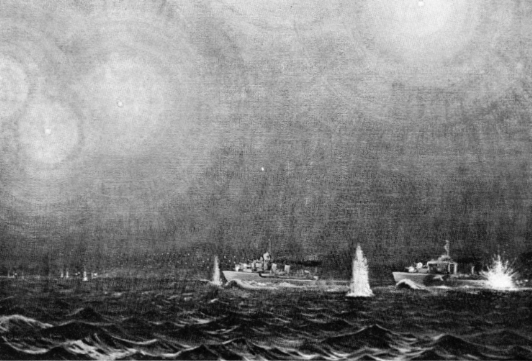THE RCN ON D-DAY
Page 2: Establishing Sea Superiority
Originally
published in the "Crowsnest Magazine" Vol. 16 No. 5 May
1964
By Lt. Peter Ward, RCNR
|
|
|
|
|
The FIRST ACTION directly connected with D-Day for the Royal Canadian Navy came in early April 1944.
The
Tribal class destroyers Haida, Athabaskan and Huron were attached
to the 10th Flotilla, a composite force which also included two
Polish destroyers. several RN destroyers and the cruiser HMS Black
Prince.
Together they were assigned to carry out Operation Tunnel, an operation with a three-fold purpose. Ships of the 10th Flotilla were to destroy enemy warships in the Channel area, disrupt coastal convoys and aid in mapping coastal defences.
Ships of the 10th Flotilla made raid after raid across the Channel, shooting up enemy convoys which wound through off-shore islands, making careful note of any batteries that fired on them, and destroying enemy surface warships.
The 10th was also doing shepherd duty for British minelayers, sowing German coastal convoy routes with random fields of explosives further to demoralize the enemy shipping which slipped from shore battery to shore battery under cover of night.
By the end of April HMCS Haida had been involved in 19 night-time Operation Tunnel sorties across the Channel.
With only six weeks to go until D-Day there were still 230 surface ships flying the German Navy flag available to fight in the Normandy area. These included 16 destroyers, 50 E-boats, 60 H-boats, armed trawlers, minesweepers, etc. If these surface ships were to make a concentrated attack on the shipping that would mass for D-Day in front of the beaches, they could create havoc and seriously jeopardize the operations. The Germans also had 130 submarines available within striking distance of the Normandy beaches, and another 70 that could be brought into action with two week’s notice.
The Tribals’ job was to destroy as many surface warships as possible, and that they did. In the four months which ended August 23, the 10th Flotilla sank 35 surface vessels, including four destroyers, and damaged 14 others.
Typical of the actions the 10th Flotilla ships fought was the fight during the night of April 25-26.
Canadians
Haida, Huron. and Athabaskan sailed with the British Tribal HMS
Ashanti and the cruiser HMS Black Prince. At 2 a.m. off Tie de Bas
the Black Prince got a radar contact at
21,000 yards, immediately confirmed by the Haida and Ashanti. Three
German Elbing class destroyers were known to to based at St. Malo
and the allied force hoped it was these Elbings they had detected.
Shortly after those blips appeared on radar screens, the enemy wheeled towards the French coast, increasing speed from 20 to 24 knots. Our ships increase to 30 knots and gave chase.
By 2.19 am range was reduced to 13,000 yards. The Black Prince opened up with star shell and her second salvo revealed three Elbings racing for home. The Haida, Athabaskan, Huron and Ashanti closed to five miles and opened fire, while the Black Prince hung back to provide illumination with her superior range.
The Ashanti drew first blood. Her shell explosions were seen through the heavy smoke made by the escaping Germans. Other flashes came through the smoke, but it was impossible to tell which Tribal had scored. The chase continued. Flying Tribals closed the range to 7,300 yards, but couldn’t see the enemy for smoke. Radar echoes were confused by rocky capes that jutted from the coast, now only 12 miles distant. The Elbings were weaving towards their home port of St. Malo.
The Haida’s radar showed the three blips had decreased to two and, at the same time, the Black Prince had a torpedo pass down her port side, apparently from the Elbing that had split from the formation. At 3.25 am the Haida spotted the Elbing that had broken away. She turned with the Athabaskan following and sent her first salvo crashing into the Elbing’s stern. Shells from both Tribals rained into the German, turning her into an inferno.
The Huron and Ashanti had lost the other two Elbings, so the four destroyers fired torpedos at the flaming enemy, which was still serving her guns through the flames. All torpedoes missed, so the Tribals circled the enemy, pouring shells into her until 4.21 when the Haida signalled the Black Prince: “Enemy has sunk.”
During
the melee the Ashanti and Huron had collided with each other, doing
considerable damage. The five ships headed for their home port of
Plymouth with battle ensigns flying.
Because of the collision, the Ashanti and Huron missed the action
three days later, in which the Haida and Athabaskan caught two Elbings
out for the night. The Haida crippled, then sank, one of the Elbings,
but a torpedo from an Elbing, struck the Athabaskan just under “X”
turret and sank her.
The Athabaskan was the only ship of the 10th Flotilla sunk during the hectic four months that ended August 23, but each of the other destroyers suffered hits at one time or another during those chilling night-time games of hide and seek through French coastal shoals.
>>> Go to Next Page
 |
|
Cdr.
Harold Beament re-created the scene of April 29, when HMC
Ships Haida and Athabaskan attacked two Elbing CLass destroyers
and the Atahbaskan was lost. He has captured the ships at
the moment that the Athabaskan was first hit by a torpedo
from an Elbing. (WA-011)
|
